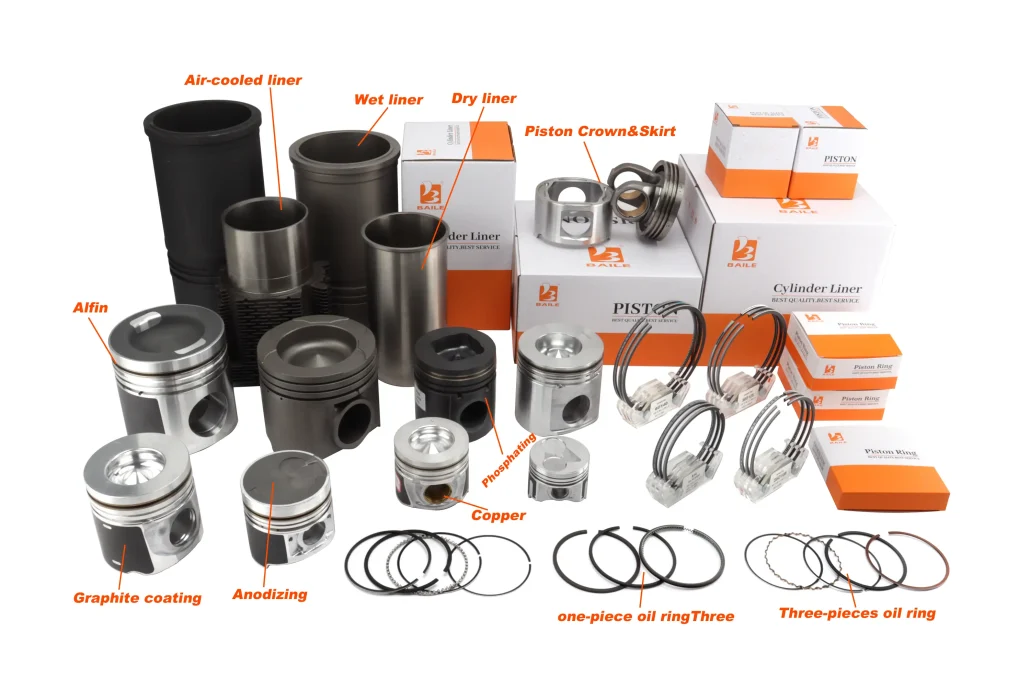In the complex structure of the engine, the piston, piston ring, and cylinder liner form the key “core three-piece set”. They directly affect the engine’s performance, durability, and fuel efficiency. Next, let’s explore the functions and characteristics of these key components.

🔧Piston: The “heart” of the engine
The piston is the core component of the reciprocating motion in the engine, which converts the gas pressure generated by combustion into mechanical energy.
Composition and function of piston
- Piston crown: the part that directly bears the high temperature and high pressure of the combustion chamber, and its shape design affects the combustion efficiency
- Piston skirt: guides the piston to move linearly in the cylinder and reduces lateral vibration
- Piston pin hole: the part that connects the connecting rod
Piston manufacturing process:
One-piece piston: integral casting or forging, simple structure, low cost
Combined piston: the top and skirt are manufactured separately and then combined to optimize the material properties of each part
Surface treatment technology:
Anodizing: improve surface hardness and heat resistance
Graphite coating: reduce friction and improve lubrication
🔧 Piston ring: the key to sealing and adjustment
The piston ring is installed in the piston ring groove, mainly for sealing, heat conduction, and lubricating oil adjustment.
Types and functions of piston rings
Gas ring (compression ring): mainly plays a sealing role to prevent gas leakage in the combustion chamber
Oil ring: controls the thickness of the oil film on the cylinder wall, ensuring lubrication and preventing excessive oil from entering the combustion chamber
One-piece Oil Ring/Combined Oil ring: simplifies the design and effectively controls oil consumption.
Three-piece Oil Ring/Whole Oil ring: provides higher sealing and adaptability, suitable for high-performance engines.
🔧 Cylinder liner: “guide rail” for piston movement
The cylinder liner is the track for piston movement and is also a component of the combustion chamber.
Classification:
Dry Liner: directly embedded in the cylinder body to provide stable support. Suitable for some engines with high performance and durability requirements.
Wet Liner: directly in contact with the coolant, with excellent heat dissipation performance. Suitable for engines with higher power.
Air-cooled Liner: relies on air to dissipate heat, common in some small engines.
💡Tip: The cooling method of the cylinder liner (air cooling or water cooling) will directly affect the heat dissipation efficiency and overall performance of the engine!
The three work together
The piston, piston ring, and cylinder liner together form a precise motion system:
The piston converts combustion pressure into mechanical motion
The piston ring ensures sealing and lubrication control
The cylinder liner provides precise motion track and heat dissipation channel
Their material selection, manufacturing process, and surface treatment technology directly affect the performance, efficiency, and life of the engine.
Summary
The piston, piston ring, and cylinder liner together constitute the core components of the engine and work together to ensure the efficient operation and durability of the engine. Whether it is daily maintenance or high-performance modification, understanding the functions and advantages of these key components can help you better choose and use the engine.
If you have any needs or questions about engine parts, please contact us! Baileparts is a professional engine parts supplier in China, providing a full range of engine parts and kits to meet all your parts needs for engine maintenance and repair.

